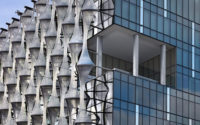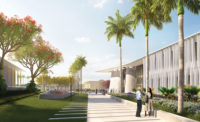Almost a decade after the U.S. Department of State ran a design competition to select an architect, the new American Embassy—or Chancery—in London by Philadelphia-based KieranTimberlake is set to open. The 12-story glass cube rises to 213 feet and wears a veil of sculptural smocking on three of its four sides. The cube, which contains more than 500,000 square feet of space, is set according to the cardinal points of the compass on a plinth partially buried in landscaped gardens. The plinth and the gardens—along with a large pond and various other artfully concealed obstructions—act as the building’s physical security cordon.
Including the land, the cost of this strategically important new overseas outpost is $1 billion—or alternatively nothing, since that money was raised by the sale of other U.S. property in London. The prime asset is the soon-to-be-decommissioned embassy in Grosvenor Square, Mayfair, a part of town where land values are sky-high. The 1960 building designed by Eero Saarinen—complete with its imposing, centrally placed gilded-aluminum bald eagle by sculptor Theodore Roszak, with a wingspan of 35 feet—is destined to be converted into a luxury hotel designed by David Chipperfield.
The eagle of the new embassy is inside, part of an enormous relief version of the U.S. seal carved into the limestone wall of the tall, imposing entrance. It immediately imparts an air of solemn purpose. This is important to James Timberlake, KieranTimberlake partner, on a wider level. “This building has to be about dignity,” he says. “It can’t be a goofy form.” Hence, he says, the eternal geometric volume of the cube.
The new embassy is a mile and a half south of the UK government’s Palace of Westminster and on the opposite bank of the Thames. It is the fulcrum of London’s largest current regeneration area, Nine Elms, where an army of brashly upmarket riverside apartment towers and slabs is springing up around the nearby landmark of the long-disused 1930s Battersea Power Station. Some $20 billion of capital investment is taking shape here, and a new branch of London’s subway system is being built to serve the emerging upscale neighborhood. The embassy will be the only architecturally sober building here, surrounded by a crowd of demonstrative drunks. Luckily it is saved from glassy blandness by its distinctive sunshading jacket and a mighty colonnade at the cube’s base.
Completion of the development surrounding the embassy is still a few years away, making it feel isolated, marooned in a muddy sea of construction sites. Its own gardens are not yet in place, although the building is otherwise finished. The facility has three separate entrances, expressed as steel-and-glass pavilions pulled away from the cube: a main entrance for officials, VIPs, and public events; one for people seeking passports, visas, and advice; and one for service and maintenance.
One aspect of the old Saarinen building in Mayfair has been adopted, consciously or otherwise: a high-ceilinged ground floor with showpiece rooms. At Nine Elms, these include a gallery, a downstairs event space, separate lobbies for the main and consular entrances, and a grand glass staircase, all set behind the colonnade, atop the half-buried plinth. Farther up in the building, the office spaces, with interiors designed by Gensler, remain high-quality if neutral—predominantly white and gray—with a few too many metal acoustic ceilings and internal corridors. The public, however, gets a higher standard, with subtly sculptural plaster ceilings in the consular areas. The steel structure is hidden away rather than expressed.
The landscaping is not confined to the exterior. Six double-height conservatory-like gardens spiral up through the building, each with its own stair connecting two or even three floors and plantings based on a different U.S. climate zone. Three of these gardens are open to the air. High up on the northeast corner, the cube breaks open into a doubleheight loggia to create an enormous private terrace, for Ambassador Robert Wood Johnson and those who will succeed him, looking directly across to Westminster. These intrusions into the cube’s otherwise pure geometry work well.
All this has been designed from the outset to be as environmentally friendly as possible, targeting LEED Platinum and its UK equivalent, BREEAM Outstanding. To achieve these goals, the building is enclosed in a triple-glazed curtain wall with the hourglass-shaped sunshades cloaking all of the facades except the north. These are made of singleskin, fritted translucent ETFE film and are set several feet in front of the curtain wall on beefy tubular steel outriggers. (A star-patterned frit is included on the glass to deter bird strikes.) Ground-source heat pumps, a rooftop photovoltaic array, chilled beams, and a heat-recovery system provide additional energy savings. Rainwater is captured and stored for toilet flushing and landscape irrigation.
Timberlake describes the building as “both evocative and performative, helping to define a new environment for diplomacy while mapping a passage towards a diplomacy for the environment.” Neat words for a neat, carefully considered object. Inside however, with the exception of the consular spaces, the embassy inevitably feels more like a conventional corporate headquarters.
About 800 staff members will begin to move in January. A dedication ceremony, with President Trump in attendance, will take place on an as yet unspecified date, probably in February. It will be his controversial first visit, and protests are inevitable. But the building will sail on, probably continuing to appear aloof. However, as its new landscape matures and the surrounding development area is built out, the project’s main urbanistic achievement should become apparent: to blend maximum security with the Anglo-American tradition of mansions set in gardens.









Post a comment to this article
Report Abusive Comment